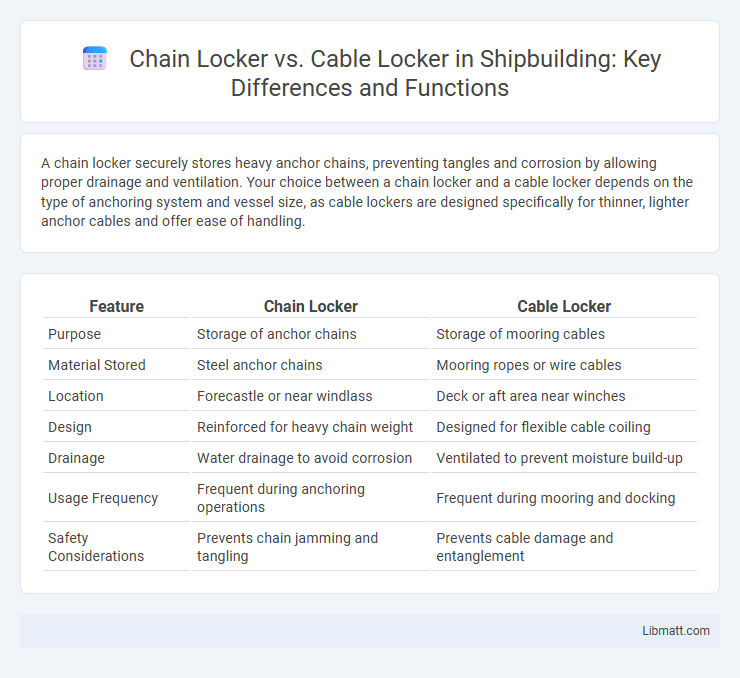A chain locker securely stores heavy anchor chains, preventing tangles and corrosion by allowing proper drainage and ventilation. Your choice between a chain locker and a cable locker depends on the type of anchoring system and vessel size, as cable lockers are designed specifically for thinner, lighter anchor cables and offer ease of handling.
Table of Comparison
| Feature | Chain Locker | Cable Locker |
|---|---|---|
| Purpose | Storage of anchor chains | Storage of mooring cables |
| Material Stored | Steel anchor chains | Mooring ropes or wire cables |
| Location | Forecastle or near windlass | Deck or aft area near winches |
| Design | Reinforced for heavy chain weight | Designed for flexible cable coiling |
| Drainage | Water drainage to avoid corrosion | Ventilated to prevent moisture build-up |
| Usage Frequency | Frequent during anchoring operations | Frequent during mooring and docking |
| Safety Considerations | Prevents chain jamming and tangling | Prevents cable damage and entanglement |
Introduction to Chain Lockers and Cable Lockers
Chain lockers and cable lockers serve essential roles in securing marine vessels by organizing and storing anchor chains or cables. A chain locker is specifically designed to hold heavy anchor chains made of metal links, providing robust storage that prevents tangling and corrosion. Cable lockers, on the other hand, accommodate lighter, flexible anchor cables or wires, ensuring your boat's anchoring system remains neat and accessible.
Definitions: What is a Chain Locker?
A chain locker is a dedicated compartment on a boat designed to store the anchor chain securely, preventing it from tangling or damaging other parts of the vessel. It is typically located near the bow and constructed to handle the weight and corrosion of metal chains. This specialized storage ensures efficient deployment and retrieval of the anchor, enhancing overall anchoring safety and convenience.
Definitions: What is a Cable Locker?
A cable locker is a security device designed to secure bicycles, motorcycles, or other valuables using a flexible steel cable coated with protective material, offering lightweight and versatile locking options. Chain lockers utilize heavy-duty metal chains enclosed in fabric or plastic sleeves, providing robust resistance against cutting but often at the expense of added weight and reduced flexibility. Cable lockers prioritize ease of use and portability, whereas chain lockers emphasize maximum protection against theft.
Key Differences Between Chain Lockers and Cable Lockers
Chain lockers provide enhanced security through heavy-duty, hardened steel links resistant to cutting and impact, making them ideal for high-theft areas. Cable lockers, composed of braided steel cables with a flexible sheath, offer lightweight convenience and portability but are more vulnerable to cable cutters. The choice between chain lockers and cable lockers depends on the required balance between security level and ease of transport or use.
Functions and Purposes of Chain Lockers
Chain lockers are specifically designed to store heavy anchor chains securely, preventing tangling and corrosion in maritime vessels. Their robust construction accommodates the significant weight and length of anchor chains, ensuring safe stowage during voyages. Unlike cable lockers, which primarily hold lighter cables and ropes, chain lockers play an essential role in anchor management and ship stability.
Functions and Purposes of Cable Lockers
Cable lockers provide secure and organized storage for cables, preventing tangling and damage while ensuring easy access. Designed for both indoor and outdoor use, they safeguard cables from environmental factors and unauthorized access. Your investment in cable lockers enhances cable management efficiency and prolongs the lifespan of crucial cabling infrastructure.
Construction and Design Considerations
Chain lockers are typically constructed from reinforced polymer or metal with ventilated compartments designed to prevent chain corrosion and facilitate drainage, while cable lockers are often made from plastic or metal with smooth, sealed interiors to protect delicate cables from abrasion and moisture. The design of chain lockers includes features such as integrated drainage holes and reinforced corners to withstand heavy loads and impact, whereas cable lockers prioritize cushioning and organized compartments to maintain cable integrity. Material choice and structural reinforcement are crucial for both, ensuring durability and protection specific to the stored item's physical properties.
Pros and Cons of Chain Lockers vs Cable Lockers
Chain lockers offer superior security with heavy-duty links resistant to cutting and sawing, making them ideal for high-risk theft areas; however, their weight and bulkiness can be cumbersome for everyday use. Cable lockers provide lightweight convenience and flexibility, easing portability and quick locking, but they are generally less secure due to thinner materials vulnerable to bolt cutters. Choosing the right option depends on Your specific security needs, balancing the trade-off between protection level and ease of use.
Applications in Maritime and Offshore Industries
Chain lockers are essential in maritime and offshore industries for securely storing anchor chains, preventing tangling and corrosion during vessel operations. Cable lockers, on the other hand, are designed specifically to house various types of electrical and communication cables, ensuring organized routing and protection from environmental damage. Both are critical for maintaining safety and efficiency on ships and offshore platforms by optimizing storage and protecting vital equipment under harsh marine conditions.
Choosing the Right Locker for Your Vessel
Choosing the right locker for your vessel depends on storage needs and security preferences; chain lockers are designed to securely store heavy anchor chains in a dedicated compartment near the bow, ensuring efficient deployment and retrieval. Cable lockers, on the other hand, accommodate mooring lines and lighter cables, offering organized storage with easy access for docking operations. Your choice should consider vessel size, anchor system, and the type of gear you use most frequently to optimize space and functionality on deck.
Chain locker vs cable locker Infographic

 libmatt.com
libmatt.com